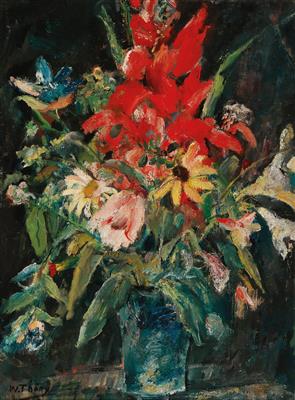Wilhelm Thöny *

(Graz 1888–1949 New York)
Colourful bouquet with gladiolas, c. 1925, signed W. Thöny, oil on canvas, 50.5 x 39 cm, framed
Christa Steinle/Günther Holler-Schuster, Wilhelm Thöny, Im Sog der Moderne, Neue Galerie Graz, Universalmuseum Joanneum, Kerber Verlag, 2013, catalogue raisonné after 153-with ill.
Provenance:
Wiener Kunstauktionen, 30 September 1997, lot 101
Private Collection, Vienna
… It is clear that Thöny paid no heed to avant-garde movements such as Cubism, Dadaism or Surrealism. He adhered to a definition of modernity which originated in the 19th century, and which, more generally, can be traced back to the past. Two key figures within the discussion of modernity should be mentioned here: Charles Baudelaire and John Ruskin. For a long time, modernity was not necessarily understood as breaking free from tradition. Rather, it was viewed as an interaction with tradition, primarily that of Greco-Roman antiquity. The present, or modern, time was viewed as being underpinned by antiquity until the 19th century. This led to a conflict as to whether the present day was equal in value to the past; this conflict would only be resolved some time later. It is important to consider that the term “modern” has existed since ancient times, and that it originally referred to updating antiquity with the aim of surpassing it. In the 19th century, the pressure to out-do antiquity faded, to the extent that something incomparable, something completely different, was now the order of the day, and this had no relation to antiquity. However, this other could not initially be defined. It was evident to Charles Baudelaire that the secret of art could no longer be found in precise depictions of nature: rather, it was to be sought in autonomous invention, in a person’s own imagination. In his view, imagination was a creative counterweight to reality, and led to external reality becoming a tool in the service of the power of imagination. Eugène Delacroix stated that „nature is merely a dictionary”, and Baudelaire took this as the core tenet of his thinking in this regard. In line with this, everything in existence could be used for art, and was then combined with the artist’s imagination to create artistic motifs. …
Günther Holler-Schuster from the aforementioned literature
21.11.2017 - 18:00
- Estimate:
-
EUR 60,000.- to EUR 80,000.-
Wilhelm Thöny *
(Graz 1888–1949 New York)
Colourful bouquet with gladiolas, c. 1925, signed W. Thöny, oil on canvas, 50.5 x 39 cm, framed
Christa Steinle/Günther Holler-Schuster, Wilhelm Thöny, Im Sog der Moderne, Neue Galerie Graz, Universalmuseum Joanneum, Kerber Verlag, 2013, catalogue raisonné after 153-with ill.
Provenance:
Wiener Kunstauktionen, 30 September 1997, lot 101
Private Collection, Vienna
… It is clear that Thöny paid no heed to avant-garde movements such as Cubism, Dadaism or Surrealism. He adhered to a definition of modernity which originated in the 19th century, and which, more generally, can be traced back to the past. Two key figures within the discussion of modernity should be mentioned here: Charles Baudelaire and John Ruskin. For a long time, modernity was not necessarily understood as breaking free from tradition. Rather, it was viewed as an interaction with tradition, primarily that of Greco-Roman antiquity. The present, or modern, time was viewed as being underpinned by antiquity until the 19th century. This led to a conflict as to whether the present day was equal in value to the past; this conflict would only be resolved some time later. It is important to consider that the term “modern” has existed since ancient times, and that it originally referred to updating antiquity with the aim of surpassing it. In the 19th century, the pressure to out-do antiquity faded, to the extent that something incomparable, something completely different, was now the order of the day, and this had no relation to antiquity. However, this other could not initially be defined. It was evident to Charles Baudelaire that the secret of art could no longer be found in precise depictions of nature: rather, it was to be sought in autonomous invention, in a person’s own imagination. In his view, imagination was a creative counterweight to reality, and led to external reality becoming a tool in the service of the power of imagination. Eugène Delacroix stated that „nature is merely a dictionary”, and Baudelaire took this as the core tenet of his thinking in this regard. In line with this, everything in existence could be used for art, and was then combined with the artist’s imagination to create artistic motifs. …
Günther Holler-Schuster from the aforementioned literature
|
Buyers hotline
Mon.-Fri.: 10.00am - 5.00pm
kundendienst@dorotheum.at +43 1 515 60 200 |
| Auction: | Modern Art |
| Auction type: | Saleroom auction |
| Date: | 21.11.2017 - 18:00 |
| Location: | Vienna | Palais Dorotheum |
| Exhibition: | 11.11. - 21.11.2017 |
